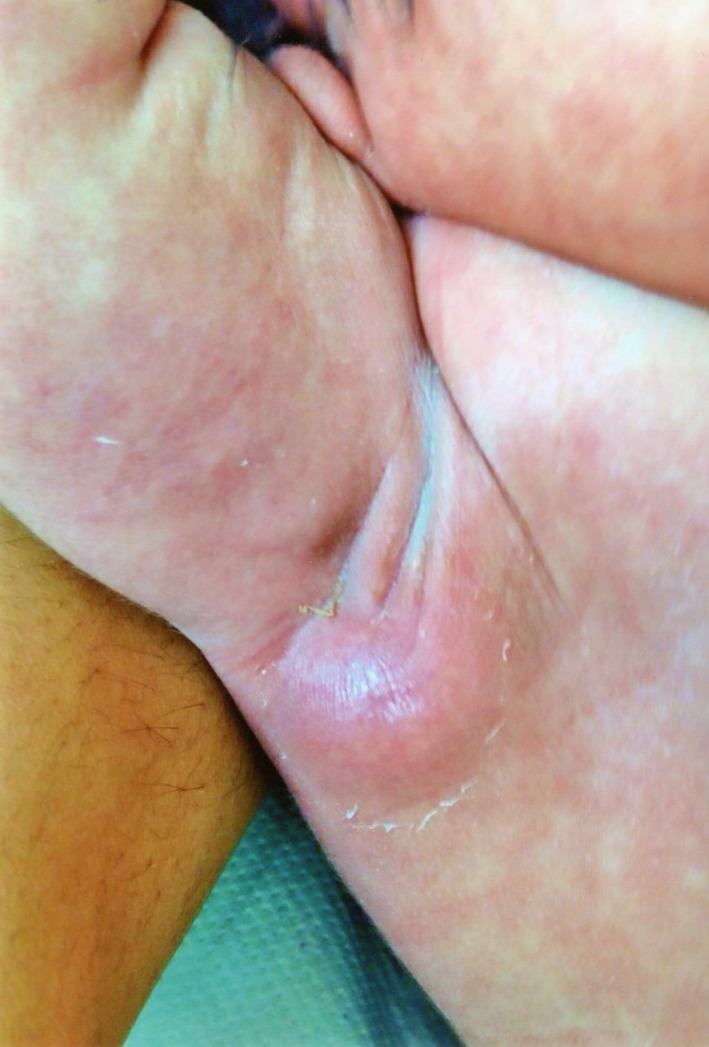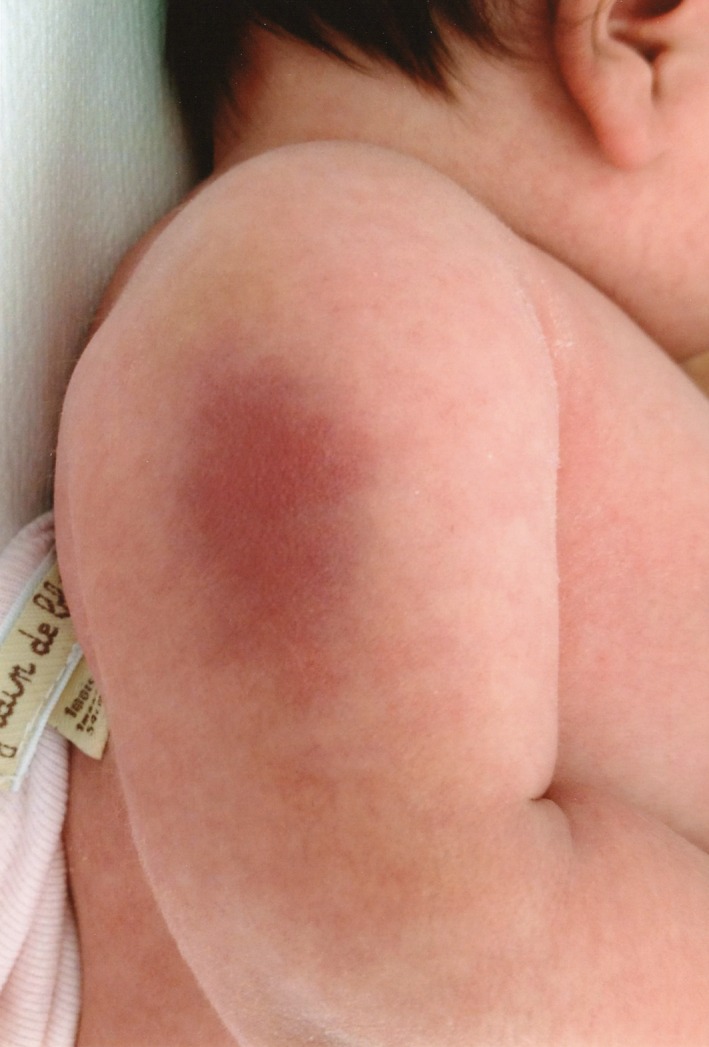Key Clinical Message
Subcutaneous fat necrosis (SCFN) is a rare fat tissue inflammation of the newborn. Risk factors include cord prolapse, perinatal asphyxia, therapeutic hypothermia, meconium aspiration, and sepsis. When present, hypercalcemia comes with lethargy, hypotonia, irritability, vomiting, polyuria, polydipsia, constipation, and dehydration. Kidney injury must be avoided. SCFN is often completely autoresolutive.
Keywords: Hypercalcemia, newborn, perinatal asphyxia, subcutaneous fat necrosis
Background
Subcutaneous fat necrosis (SCFN) of the newborn is a rare inflammatory disorder of the fat tissue presenting in term and postterm infants 1, consisting in a lobular form of panniculitis associated to painful, hard, and erythematous–violaceous nodules (Figs. 1 and 2) 2. SCFN usually has a favorable prognosis, with complete autoresolution of subcutaneous lesions within several weeks or months, but it may also be complicated by serious metabolic alterations 3.
Figure 1.

Patient 1: Subcutaneous fat necrosis (SCFN) hard nodules covered by erythematous skin, localized on the right arm and on the right armpit.
Figure 2.

Patient 2: Purplish, indolent, infiltrated erythematous plaque on the upper arm (day #4 of life), consistent with SCFN.
Patient 1
A male term newborn was delivered vaginally at 38 + 2 gestational weeks after labor induction for fetal macrosomia. Birth weight was 4170 g. Gravidic history was unremarkable. The patient needed cardiopulmonary resuscitation at birth due to neonatal asphyxia. Apgar score was 1, 5, and 8 at 1, 5, and 10 min, respectively. Cord blood gas analysis showed metabolic acidosis (pH 7.12, pco 2 36 mmHg, HCO3 11.7 mmol/L, BE −16.7 mmol/L). In the first hours after admission to our Neonatal Intensive Care Unit (NICU), he presented with hypoglycemia responsive to IV glucose infusion. Other laboratory results included: ALT 229 U/L, CPK 2105 U/L, troponin I 0.074 ng/mL, creatinine 0.82 mg/dL, blood urea nitrogen 29 mg/dL, calcium 10.4 mg/dL. There were no neurological complications. On day #11 of life, the patient presented with painful subcutaneous hard nodules covered by erythematous skin. These lesions were localized on the right arm and on the right armpit (Fig. 1), and were consistent with nodules of SCFN. Serum calcium was slightly increased (11.2 mg/dL) at this time point; further monitoring showed spontaneous normalization of serum calcium, which remained normal post discharge. On the occasion of the follow‐up visit 3 months post discharge, the baby was in good clinical condition with an appropriate‐to‐age neurological development.
Patient 2
A full‐term infant girl (40 + 4 gestational weeks) was born by cesarean section for mechanical dystocia with premature rupture of membranes (PROM) 24 h before, with stained amniotic fluid. Her mother had fever in the postpartum and her blood culture turned positive for Escherichia coli, so she was administered antibiotic treatment. The baby's birth weight was 3940 g (90th–97th percentile, i.e., large for gestational age [LGA]), length was 50.5 cm (50th–75th percentile), and head circumference was 35 cm (50th–75th percentile). Soon after birth, the patient developed severe perinatal distress, which rapidly improved with noninvasive ventilatory support in delivery room. Apgar score was 1, 4, and 9 at 1, 5, and 10 min, respectively. She received noninvasive ventilatory support for 48 h after birth.
Inflammatory markers at birth (C‐reactive protein, CRP) were normal. Arterial cord blood gas analysis showed pH 7.05, pco 2 69 mmHg, BE −12.3 mmol/L, lactate 7.8 mmol/L. On day #2 of life, an infiltrated erythematous plaque was observed on the right arm, this lesion turned into a purplish hue 2 days later (Fig. 2), with no associated tenderness or enlargement. An X‐ray excluded fractures. Predischarge blood tests performed on day #7 of life showed mild hypercalcemia (calcium 11.1 mg/dL) with normal platelet count. Basing on clinical history, physical examination, and biochemical parameters, the erythematous lesion of the arm was diagnosed as SCFN. The neurological outcome was favorable, as assessed on the occasion of the 3 months follow‐up visit postdischarge.
Discussion
Subcutaneous fat necrosis of the newborn (SCFN) represents a benign condition occurring in the neonatal period 4, characterized by inflammation and necrosis of subcutaneous fat tissue and typically presenting with subcutaneous purple‐bluish hard nodules (see Figs. 1 and 2) 5. Lesions may appear isolated or clustered and are typically located on shoulders, back, buttocks, and face 6; nodules may evolve into subcutaneous calcifications 5.
Etiology of this disorder is unknown, but it is linked to multiple neonatal and maternal risk factors (Table 1) 2. Physiopathology of SCFN may involve a precocious phase of impaired tissue perfusion with subsequent tissue hypoxia leading to crystallization of neonatal subcutaneous fat, followed by tissue necrosis and granulomatous reaction 6.
Table 1.
Neonatal and maternal risk factors for SCFN of the newborn
| Neonatal risk factors | Maternal risk factors |
|---|---|
|
|
Subcutaneous fat necrosis is usually a benign condition. Nevertheless, it may be associated with thrombocytopenia, hypoglycemia, hypercalcemia, and hypertriglyceridemia 2; these metabolic derangements may, in turn, represent a possible risk for serious complications 2.
Thrombocytopenia is usually synchronous with the appearance of subcutaneous nodules, and it is possibly caused by peripheral platelet sequestration into the lesions 7, 8.
Hypoglycemia is reported in literature as another risk factor linked to SCFN, but rather than being a cause of SCFN it seems to be itself a consequence of hypoxia 1.
Hypertriglyceridemia is caused by mobilization of fatty acids from adipose tissue 3.
Hypercalcemia is found in 25% of cases 5 and represents the most serious potential complication, associated with significant mortality and morbidity 1. The first 6 weeks of life represent the time frame at highest risk for clinically significant hypercalcemia in SCFN, with 40% of cases occurring in this lapse of time 9.
Usually, serum calcium starts to rise as SCFN lesions begin to regress; sometimes, hypercalcemia is already detectable before the onset of subcutaneous lesions 5. Neonates with hypercalcemia tend to present with lethargy, hypotonia, irritability, vomiting, polyuria, polydipsia, constipation, and dehydration 8. Hypercalcemia is caused by increased prostaglandin activity, release of calcium from necrotic fat tissue, and increased secretion of 1,25‐dihydroxyvitamin D3 from subcutaneous lesions, leading to an increased intestinal uptake of calcium 2. If left untreated, moderate to severe hypercalcemia may lead to complications as nephrocalcinosis, nephrolithiasis, renal failure; calcification of falx cerebri, skin, myocardium, and gastric mucosa may also occur 2, 8.
Treatment of hypercalcemia consists of hyperhydration and diet with low levels of calcium and vitamin D; sometimes, other drugs like furosemide and prednisolone are needed to decrease serum calcium 2; bisphosphonates (e.g., etidronate) may also be employed to treat moderate to severe hypercalcemia when other measures have proven ineffective 10.
In children with a personal history of SCFN it is recommended to evaluate serum calcium levels periodically until the age of 6 months 8.
Conclusions and Final Remarks
Subcutaneous fat necrosis is usually a transient and self‐limited condition. However, it may be complicated by a number of metabolic alterations like thrombocytopenia, hypoglycemia, hypercalcemia, and hypertriglyceridemia. It is pivotal to monitor newborns with SCFN to avoid the risk of serious complications, with particular reference to hypercalcemia. Regular monitoring of serum calcium is recommended until the age of 6 months, in infants with personal history of SCFN.
Conflict of Interest
None declared.
Acknowledgments
We thank our friends and colleagues Ian Taylor, MD (Emergency Medicine Department, University of Ottawa), Marco Gasparetto, MD, PhD (Senior Clinical Fellow in Paediatric Gastroenterology at Cambridge University Hospitals, United Kingdom), and Megan Roberts (PR and Brand Communications Manager, Degree in English Literature, University of Cambridge) for their precious help in revising the English of the manuscript.
Clinical Case Reports 2015; 3(12): 1017–1020
References
- 1. Calisici, E. , Oncel M. Y., Degirmencioglu H., Sandal G., Canpolat F. E., Erdeve O., et al. 2013. A neonate with subcutaneous fat necrosis after passive cooling: does polycythemia have an effect? Case Rep. Pediatr. 2013:254089. [DOI] [PMC free article] [PubMed] [Google Scholar]
- 2. Canpolat, N. , Özdil M., Kuruğoğlu S., Çalışkan S., and Sever L.. 2012. Nephrocalcinosis as a complication of subcutaneous fat necrosis of the newborn. Turk. J. Pediatr. 54:667–670. [PubMed] [Google Scholar]
- 3. Mahé, E. , Girszyn N., Hadj‐Rabia S., Bodemer C., Hamel‐Teillac D., and De Prost Y.. 2007. Subcutaneous fat necrosis of the newborn: a systematic evaluation of risk factors, clinical manifestations, complications and outcome of 16 children. Br. J. Dermatol. 156:709–715. [DOI] [PubMed] [Google Scholar]
- 4. Feng, Z. , Guo B., and Zhang Z.. 2014. Subcutaneous fat necrosis of the newborn associated with hypercalcemia after therapeutic hypothermia. J. La State Med. Soc. 166:97–99. [PubMed] [Google Scholar]
- 5. Gomes, M. P. , Porro A. M., Enokihara M. M., and Floriano M. C.. 2013. Subcutaneous fat necrosis of the newborn: clinical manifestations in two cases. An. Bras. Dermatol. 88:154–157. [DOI] [PMC free article] [PubMed] [Google Scholar]
- 6. Coondoo, A. , Lahiry R., Choudhury A., and Sengupta S.. 2013. Tender skin nodules in a newborn. Indian J. Dermatol. 58:328. [DOI] [PMC free article] [PubMed] [Google Scholar]
- 7. Chen, T. H. , Shewmake S. W., Hansen D. D., and Lacey H. L.. 1981. Subcutaneous fat necrosis of the newborn. A case report. Arch. Dermatol. 117:36–37. [PubMed] [Google Scholar]
- 8. Tran, J. T. , and Sheth A. P.. 2003. Complications of subcutaneous fat necrosis of the newborn: a case report and review of the literature. Pediatr. Dermatol. 20:257–261. [DOI] [PubMed] [Google Scholar]
- 9. Shumer, D. E. , Thaker V., Taylor G. A., and Wassner A. J.. 2014. Severe hypercalcaemia due to subcutaneous fat necrosis: presentation, management and complications. Arch. Dis. Child. Fetal Neonatal Ed. 99:F419–F421. [DOI] [PMC free article] [PubMed] [Google Scholar]
- 10. Pérez Martínez, E. , Camprubí Camprubí M., Ramos Cebrián M., Antón López J., Apodaca Saracho A., Lopez Ramos M. G., et al. 2014. Treatment with bisphosphonates in severe hypercalcemia due to subcutaneous fat necrosis in an infant with hypoxic‐ischemic encephalopathy. J. Perinatol. 34:492–493. [DOI] [PubMed] [Google Scholar]


